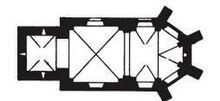Chapel on the Fürstenberg
The chapel on the Fürstenberg is located on the summit of the mountain of the same name (279 m above sea level) in the area of the municipality of Ense . Their origins go back to the 15th century.
history
On the mountain that lay Electorate of Cologne country Burg Fürstenberg Castle which was first mentioned 1295th At the same time, Hermann von Fürstenberg, the first representative of the Westphalian noble family Fürstenberg , was named as Burgmann . This came from the Binolen family but was named after the castle.
The chapel on the mountain was first mentioned on April 12, 1429. There it says " ... dat brings umme dei kercken to deme Vorstenberghe sal staen, alse det alderen gesat lift " ( ... the wood around the chapel on the Fürstenberg should remain, as the parents said ). After that, it must be a bit older than when it was first mentioned. There are only a few sources of evidence for the following period up to the 17th century.
There is an inscription above the entrance gate. This shows that Prince-Bishop Dietrich von Fürstenberg had the chapel restored in 1610. It is possible that the chapel was damaged in the Truchsess riots . However, the inscription itself only dates from 1663 in the course of an extension by Prince-Bishop Ferdinand von Fürstenberg . There is an inscription on the portal arch with reference to the renewal and expansion by Ferdinand von Fürstenberg.
On an artistically u. a. Ferdinand's cartouche with a coat of arms from 1665 behind the altar is known as the family chapel. The hardships of the times and the war are given as reasons for the collapse since 1610. The inscription also shows that it is dedicated to the apostles Philip and James .
After the renovation by Ferdinand, the chapel later fell into disrepair. The demolition was already planned in the 19th century and a wayside shrine was to be installed in its place. The restoration followed in 1826 by Theodor von Fürstenberg. The chapel was restored for the last time between 1991 and 1998.
After a break, the original figures of were facilities in the Herdringen brought.
Construction and equipment
The current building dates from the Renaissance period . It is single-aisled and single-yoke. The choir is single yoke with a 3/6 end. There is a tower to the west.
A baroque altar dates from Ferdinand's time with a central altar painting and two almost life-size apostle figures of Philip and James. The altarpiece is framed by two winding columns, surrounded by vines. There is a blown gable above the picture.
The original altar painting has disappeared. Instead, the altar contains a picture, presumably from 1912, that shows the apostles around the empty tomb of Mary and her coronation in heaven.
During restoration work in 1993, a mural was found that presumably dates from the time of Ferdinand von Fürstenberg and depicts Saint Philip. The craftsmanship and stylistic similarities could point to the painter Johann Georg Rudolphis .
A Madonna from 1710 was also part of the furnishings. The sculpture is about 120 cm high and shows Mary standing on a crescent moon with the infant Jesus in her arms. This in turn stands on a globe, entwined by snakes. Because of the similarity with works by Heinrich Stütting, the Madonna is assigned to this artist.
The figure of Saint Liborius dates from 1739, is 145 cm high and comes from the school of Johann Philipp Pütt from Paderborn. A figure of St. Lambertus is 145 cm high and dates from the 19th century.
The 70 kg bell was placed in the chapel in 1826. It's medieval. The exact time it was created is unclear. Different interpretations range from the 11th to the 14th century.
literature
- Michael Jolk: The chapel on the Fürstenberg. In: The Fürstenberg. Chapel, bath house, vegetation and medicinal herbs. In: Westphalian art sites. Issue 92, 2002, published by the Westfälischer Heimatbund, pp. 3–22.
- Horst-Dieter Czembor. Altar painting shows the coronation of Mary. Fürstenberg chapel built in the 14th century. In: The Cathedral . No. 5, February 2, 2014, p. 19.
Web links
Coordinates: 51 ° 28 ′ 22.1 ″ N , 7 ° 56 ′ 48.8 ″ E

